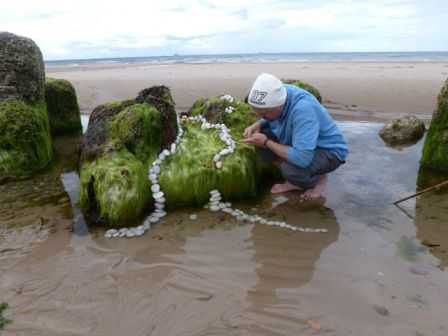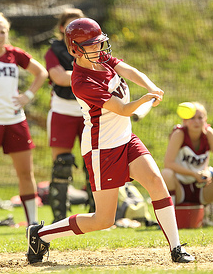If you want to succeed, embrace failure.
A year ago, I would have expected such paradoxical advice to come from a Taoist monk or a Jedi master. Now, after a sabbatical year away from school, I find myself touting that same refrain as I explore questions about teaching and learning. How do I encourage the freshman boy who struggles on an early test? How do I help a rookie softball shortstop maintain her confidence when her throw sails over the first baseman’s head? How do I support the senior who’s worried about getting rejected by her first-choice school?
Even though we at Northfield Mount Hermon see ourselves as an open-minded prep school—not just getting kids to the “top” colleges, but to the schools and programs that fit them best—we still employ many of the same measuring sticks that our peers do. We want our kids to excel in academics, arts and athletics—nail all three, even better. To the teenage mind, a single failure can sometimes feel ruinous. Lose one game and you miss the playoffs. Get one B and you might get rejected at Princeton. Such a high-pressure house of cards leaves little room for exploring uncertain ground and crowds out the benefits of healthy risk-taking.
During my sabbatical explorations last year, I studied how to foster a more courageous, creative, and connected classroom. More specifically, I explored how four varied fields—contemplative practice, improvisational theater, positive reinforcement behavioral training, and growth mindset work—could overlap in such an effort. Some of my colleagues chuckled at the scope and complexity of the project—a year long drink at the fire hydrant, eh?—but I sensed I’d find valuable insights.
My travels led me to create art in nature at an eco-spiritual community on the coast of Scotland and sing Spontaneous Broadway on the improv stages of San Francisco. I watched an NCAA champion softball coach lead practice in Florida and heard mythical tales of powerful horses in Iceland. I learned about mindset in a conversation with a psychology professor at Stanford and about compassion from some street vendors in Venice, Italy. Everything I encountered, it seemed, invited me to shift my way of thinking about failure.
For example, most contemplative traditions use a gentler approach to so-called mistakes. When attention strays from a focus point—the breath, for example—there’s no ridicule or shaming. One simply notices the straying and gets back to the focusing. The lapse becomes a lesson.
When I struggled last summer to build a fragile trail of stones extending from a boulder into a tidal pool, I remembered the words of nature artist Andy Goldsworthy in the documentary Rivers and Tides as he laments a fallen stone sculpture:
“The moment when it collapses is intensely disappointing. This is the fourth time it’s fallen, and each time I got to know the stone a little bit more, it got higher each time. It grew in proportion to my understanding of the stone.”He then pauses before adding:
“I obviously don’t understand it well enough yet.”Again, no self-flagellation, only the recognition that he’s learning—and needs to learn more.
The theater improvisors I met showed me how to rebound from muck-ups with a practice known as the Failure Bow. Rather than compound a mistake by wincing from expected punishment—external or internal—the actor defuses the failure by taking a proud step forward and throwing both arms in the air to declare “I failed! Woo hoo!” In other words, Yes, I messed up. And yes, I’m still here. I’m still growing. Such cheerful resilience delights audiences and inspires stagemates. And the eagerness is infectious.
Behavioral trainers and coaches who employ positive reinforcement methods—reward movement toward the behavior you want and ignore the rest—don’t harp on failure either. I can use a “tag,” a non-verbal audible marker like a snap or a click, to let a softball player know when she’s got her wrists in proper position to make a great swing, for example. The tag says “Yes.” If she doesn’t hear the sound, I don’t point out the error or offer more instruction. I stay silent. There’s no dishonor or derision, only the information the player needs. In the quiet, she then determines the necessary adjustment and receives reinforcement from me the moment she finds the right alignment. Her ‘failure’ provides feedback. It leads to the solution.
Someone with a fixed mindset believes that whatever abilities we have come set in stone. No amount of effort can make up for a lack in talent and, in fact, effort demonstrates a lack of talent. A growth mindset, in contrast, suggests greater fluidity in intelligence and ability. Those who see their apparent failures as prototypes for future success maintain the courage and resilience to keep going. They stoke their flames for further learning—and ultimately reach farther than others who think they’re fixed.
These attitudes toward failure may seem revolutionary in educational settings, where we so often focus only on success, but tilling new soil often bears huge fruit. Errors in the classroom—or on the playing field, or the stage, or wherever students are absorbing new information—offer valuable information for incremental improvement and sometimes bust open the window to previously unforeseeable innovation. In failure, we can all find wisdom and opportunities for real learning. No Jedi master or Taoist sage necessary.
An abridged version of this post first appeared in the November 2013 issue of the NMH Alumni magazine. Special thanks to Jennifer Sutton in the NMH Communications office for her help crafting the piece.




Maybe it’s not the “errors” or the “mistakes” but the need for “asset” language — “learning opportunities”, “attempts”, “risk-taking”. Every success starts with one step — some forward, some sideways, some backward but always in motion. How do we help keep students believing in themselves when they perceive that others don’t believe in them — whether the case is true or not? Positively affecting self-perceptions in that mindset is of interest to me as an educator.
That’s a great question, Susan! I sense that at least part of the answer lies in helping them develop that growth mindset, first, and then giving them more skills to translate their learning experience on their own terms. It’s like an inoculation to the debilitating aspects of criticism. Corrective information coming in? OK, activate translators and listen for possibilities for playful improvement. And so on….
wonderful and true. so great that you took this journey to understanding. (ps andy g is my favorite artist, both for his work and his philosophy). the future kids you teach will all benefit from your learning.